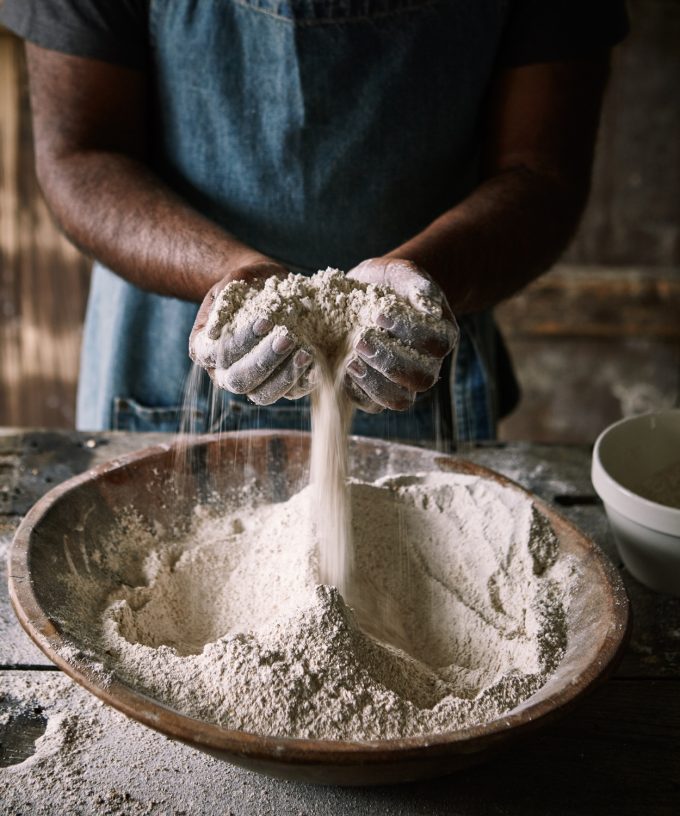
Freshly Milled Flour, Oxidation, and Green Flour
Freshly milled flour that has not had time to oxidise retains many of its natural nutrients and flavours. This is because the milling process releases oils and other compounds that are rich in vitamins, minerals, and enzymes. If the flour is used immediately, these beneficial nutrients are still intact.
Key Points:
- Nutrient Retention: Freshly milled flour maintains more of the grain’s original vitamins and minerals, which can degrade over time when exposed to light and air.
- Flavour: It offers a richer, more complex flavour profile due to the fresh oils and compounds released during milling.
- Enzyme Activity: Freshly milled flour has active enzymes that aid in fermentation, breaking down starches and proteins, enhancing dough workability and bread texture.
- Oxidation Process: Over time, flour oxidises, leading to a loss of nutritional value and flavour. Oxidation can also cause the flour to become rancid due to the degradation of oils, negatively affecting taste and health.
Green Flour and Its Weakness
Green flour refers to freshly milled flour that is used immediately after milling. While it is rich in nutrients and flavour, it tends to be weak in terms of gluten strength.
Reasons for Weakness:
- Immature Gluten Network: The gluten in freshly milled flour has not had time to develop strength. Gluten is a network of proteins that provides elasticity and structure to dough. This network requires time to form properly.
- Oxidation for Strength: As freshly milled flour oxidises over a period of 24-48 hours, the gluten proteins undergo changes that strengthen the gluten network. This process is known as maturation or aging.
- Dough Development: During this maturation period, the dough becomes more extensible and elastic, which is essential for good bread structure. Using green flour too soon can result in weak, sticky dough that does not hold its shape well.
Using freshly milled flour or green flour can significantly enhance the nutritional value and flavour of your bread. However, allowing the flour to oxidise and mature for at least 24 hours is crucial for developing the gluten strength needed for a strong, elastic dough. Balancing these aspects can lead to healthier, tastier, and better-structured bread.
Freshly Milled Flour, Oxidation, and Green Flour
Freshly milled flour that has not had time to oxidise retains many of its natural nutrients and flavours. This is because the milling process releases oils and other compounds that are rich in vitamins, minerals, and enzymes. If the flour is used immediately, these beneficial nutrients are still intact.
Key Points:
- Nutrient Retention: Freshly milled flour maintains more of the grain’s original vitamins and minerals, which can degrade over time when exposed to light and air.
- Flavour: It offers a richer, more complex flavour profile due to the fresh oils and compounds released during milling.
- Enzyme Activity: Freshly milled flour has active enzymes that aid in fermentation, breaking down starches and proteins, enhancing dough workability and bread texture.
- Oxidation Process: Over time, flour oxidises, leading to a loss of nutritional value and flavour. Oxidation can also cause the flour to become rancid due to the degradation of oils, negatively affecting taste and health.
Green Flour and Its Weakness
Green flour refers to freshly milled flour that is used immediately after milling. While it is rich in nutrients and flavour, it tends to be weak in terms of gluten strength.
Reasons for Weakness:
- Immature Gluten Network: The gluten in freshly milled flour has not had time to develop strength. Gluten is a network of proteins that provides elasticity and structure to dough. This network requires time to form properly.
- Oxidation for Strength: As freshly milled flour oxidises over a period of 24-48 hours, the gluten proteins undergo changes that strengthen the gluten network. This process is known as maturation or aging.
- Dough Development: During this maturation period, the dough becomes more extensible and elastic, which is essential for good bread structure. Using green flour too soon can result in weak, sticky dough that does not hold its shape well.
Using freshly milled flour can significantly enhance the nutritional value and flavour of your bread. However, allowing the flour to oxidise and mature for at least 24 hours is crucial for developing the gluten strength needed for a strong, elastic dough. Balancing these aspects can lead to healthier, tastier, and better-structured bread.
Freshly milled flour that has not had time to oxidise



